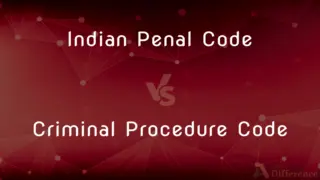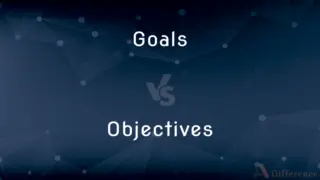Vertebrates vs. Invertebrates — What's the Difference?
By Tayyaba Rehman — Published on December 16, 2023
Vertebrates have a backbone or spinal column; Invertebrates do not. Both vertebrates and invertebrates play crucial roles in the ecosystems, contributing to biodiversity and functioning of various habitats.

Difference Between Vertebrates and Invertebrates
Table of Contents
ADVERTISEMENT
Key Differences
Vertebrates are animals that possess a backbone or a spinal column, which is a defining feature of the subphylum Vertebrata. These creatures range from fish to mammals. Invertebrates, on the other hand, encompass all animals that do not have a backbone, including organisms like jellyfish, worms, and insects.
Vertebrates typically have more complex structures, with well-developed internal organs and systems. Invertebrates, conversely, often have simpler body plans but can be just as specialized in their respective habitats.
Vertebrates, with their backbones, have an internal skeletal system made of bone or cartilage, aiding in movement and providing structural support. Invertebrates might use exoskeletons, hydrostatic skeletons, or have no hard support structures at all.
Comparison Chart
Presence of Backbone
Have a backbone or spinal column
Do not have a backbone or spinal column
Body Complexity
Generally more complex body systems
Simpler body systems
ADVERTISEMENT
Skeletal System
Internal skeletal system (bone/cartilage)
May have exoskeleton or no hard structures
Examples
Fish, birds, mammals, reptiles, amphibians
Jellyfish, worms, insects, spiders, mollusks
Percentage in Animal Kingdom
Less than 5% of all animals
More than 95% of all animals
Compare with Definitions
Vertebrates
Members of the animal kingdom with a segmented spinal structure.
Reptiles, like snakes and lizards, are vertebrates with unique adaptations.
Invertebrates
Animals lacking a backbone or spinal column.
Butterflies, as invertebrates, undergo metamorphosis during their life cycle.
Vertebrates
Animals with a backbone or spinal column.
Fish are one of the many types of vertebrates.
Invertebrates
Creatures often with simpler body plans than vertebrates.
Starfish, as invertebrates, have a unique radial symmetry.
Vertebrates
Animals with well-developed internal organs and systems.
Mammals, as vertebrates, have complex respiratory and circulatory systems.
Invertebrates
The most diverse and numerous group within the animal kingdom.
Most of the species discovered in the rainforest are invertebrates, from beetles to spiders.
Vertebrates
Creatures with an internal skeletal system made of bone or cartilage.
Unlike some vertebrates, sharks have skeletons made of cartilage.
Invertebrates
Animals that may use exoskeletons or hydrostatic skeletons for support.
Crabs, as invertebrates, have a hard exoskeleton to protect them.
Vertebrates
Organisms belonging to the subphylum Vertebrata.
Birds, as vertebrates, have a skeletal system that aids in flight.
Invertebrates
Organisms not belonging to the subphylum Vertebrata.
The vast majority of ocean species are invertebrates, including many coral species.
Vertebrates
Having a backbone or spinal column.
Invertebrates
Lacking a backbone or spinal column; not vertebrate.
Vertebrates
Of or characteristic of vertebrates or a vertebrate.
Invertebrates
Of or relating to invertebrates
Invertebrate zoology.
Vertebrates
Any of numerous chordate animals of the subphylum Vertebrata, characterized by a segmented spinal column and a distinct well-differentiated head. The vertebrates include the fishes, amphibians, reptiles, birds, and mammals.
Invertebrates
An animal, such as an insect or mollusk, that lacks a backbone or spinal column.
Vertebrates
Plural of vertebrate
Invertebrates
Plural of invertebrate
Common Curiosities
What are Vertebrates?
Vertebrates are animals that have a backbone or spinal column.
Do Vertebrates have a more complex body system than Invertebrates?
Generally, yes. Vertebrates typically have more complex structures and systems.
What's the skeletal system like in Invertebrates?
Invertebrates may have exoskeletons, hydrostatic skeletons, or no hard structures.
Can you name some examples of Vertebrates?
Yes, examples include fish, birds, mammals, reptiles, and amphibians.
And how much of the animal kingdom do Invertebrates make up?
Invertebrates make up more than 95% of all animals.
What are Invertebrates?
Invertebrates are animals that do not have a backbone or spinal column.
Are all Vertebrates warm-blooded?
No, only birds and mammals among the vertebrates are warm-blooded.
What are some examples of Invertebrates?
Examples include jellyfish, worms, insects, spiders, and mollusks.
Are humans Vertebrates or Invertebrates?
Humans are vertebrates, as we have a backbone.
How much of the animal kingdom do Vertebrates constitute?
Vertebrates make up less than 5% of all animals.
Do all Vertebrates have bones?
No, some vertebrates, like sharks, have cartilage instead of bones.
How do Invertebrates support their body without a backbone?
Invertebrates can have exoskeletons, hydrostatic skeletons, or other structural adaptations.
Do Invertebrates have brains?
Some invertebrates have simple brains, while others have nerve nets or ganglia.
Which group is older in evolutionary terms, Vertebrates or Invertebrates?
Invertebrates are older, with many groups appearing before the first vertebrates.
Do Invertebrates play a significant role in the ecosystem?
Yes, invertebrates are crucial for various ecosystem functions, from pollination to decomposition.
Share Your Discovery

Previous Comparison
Indian Penal Code vs. Criminal Procedure Code
Next Comparison
Goals vs. ObjectivesAuthor Spotlight
Written by
Tayyaba RehmanTayyaba Rehman is a distinguished writer, currently serving as a primary contributor to askdifference.com. As a researcher in semantics and etymology, Tayyaba's passion for the complexity of languages and their distinctions has found a perfect home on the platform. Tayyaba delves into the intricacies of language, distinguishing between commonly confused words and phrases, thereby providing clarity for readers worldwide.














































